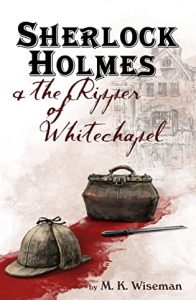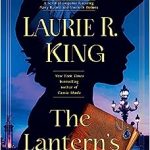 Sherlock Holmes & the Singular Affair by M.K. Wiseman
Sherlock Holmes & the Singular Affair by M.K. Wiseman Format: eARC
Source: supplied by publisher via Edelweiss
Formats available: hardcover, paperback, ebook
Genres: historical fiction, historical mystery, mystery
Pages: 200
Published by M.K. Wiseman on December 7, 2021
Purchasing Info: Author's Website, Amazon, Barnes & Noble, Kobo, Bookshop.org
Goodreads
Before Baker Street, there was Montague.
Before partnership with a former army doctor recently returned from Afghanistan, Sherlock Holmes had but the quiet company of his own great intellect. Solitary he might be but, living as he did for the thrill of the chase, it was enough.
For a little while, at the least, it was enough.
That is, until a client arrives at his door with a desperate plea and an invitation into a world of societal scandal and stage door dandies. Thrust deep in an all-consuming role and charged with the safe-keeping of another, Holmes must own to his limits or risk danger to others besides himself in this the case of the aluminium crutch.
My Review:
After last week’s marvelous book, I was looking for more Sherlock Holmes – as is often the case. So here we are with this little gem.
Many, it feels like most, Sherlock Holmes stories purport to be written by another, usually Dr. John H. Watson, and published by a third or fourth party. By presenting the story as being another person’s recollections and/or impressions of the Great Detective, while the reader is left thinking that they know what Holmes was “like”, what they really know is what the writer/observer “thought” Holmes was like.
As a writing device, it puts Holmes at one or more removes, as the writer imbues the character with his or her own slant on what Holmes thought and did, and then the reader slants that slant. Which fits fairly well with Holmes’ perception or presentation of himself as a thinking machine with few human emotions.
It’s also part of what makes the saying that “every generation has its Sherlock” so true, in that a 21st century author has the opportunity to fit Holmes into the writer’s time and place – as Conan Doyle himself did – or the reader’s time and place or any other in between depending on who is used as Holmes’ biographer/narrator.
This particular entry in the not-quite-canon of Holmes pastiches takes an entirely different tack. The Singular Affair that Holmes must deal with in this adventure occurred before he ever met Watson. Holmes is young – only 26 – and living alone on Montague Street in a flat that is in no way large enough to contain his experiments, his office, and himself.
In other words, his housekeeping is atrocious, there is no Mrs. Hudson in sight, and the tools of his trade have outgrown any and all possible housing for them in the space available. Or, in his present circumstances, affordable.
It allows us to see that Holmes already needs Watson, even if he doesn’t believe he will ever find someone who will be able to tolerate his work, his mess, his single-mindedness or himself with any degree of equanimity.
So Holmes is at the beginning of his career, just far enough along that his name opens many doors – and closes a few others. He has no one to serve as his amanuensis, so he tell the story himself.
But it is removed, as this story is in a manuscript that Dr. John H. Watson discovers amongst Holmes’ papers in the wake of the Great Detective’s death. It’s a story that Holmes tells, but one that he tells of his early career written at the end of his long and celebrated one.
And what a fascinating tale it is.
 Escape Rating B: On the one hand, the story does its best to read as the kind of adventure that Watson so successfully wrote. It is chock full of desperate clients, misdirection, multiple identities and shady underworld connections as any Holmes’ fan might wish.
Escape Rating B: On the one hand, the story does its best to read as the kind of adventure that Watson so successfully wrote. It is chock full of desperate clients, misdirection, multiple identities and shady underworld connections as any Holmes’ fan might wish.
At the same time, it also includes a bit more feeling and not-quite-purple prose than one’s interpretation of Holmes would lead one to expect. The sort of prose and the sort of internal feelings that were part of Watson’s narration but aren’t as expected coming from Holmes’ own pen based on the interpretation of the man that we are familiar with from the pen of Watson.
(The author’s previous foray into Holmes pastiches, Sherlock Holmes & the Ripper of Whitechapel, also foregoes the use of Watson as chronicler, but for an entirely different reason. if this author continues her chronicles of Holmes’ adventures we’ll see if this trend continues in any form. I hope we do.)
On yet another hand, the story is of Holmes’ own early days, when he was both a bit full of the false sense of immortality that we all are capable of at that age, while still more than occasionally being hit upside the head – sometimes literally – by the things he does not yet know or understand.
So the case, as his cases often do, starts out simple to the point of not seeming to be worth his time, only to end up nearly getting Holmes and the man he originally thought was the villain, killed.
It begins with a young woman who is certain that her childhood friend and correspondent has been abducted and that someone else has taken his place – even though everyone else tells her that she’s wrong. She’s not, of course, or Holmes wouldn’t have a case to follow.
But in the best Holmesian traditional mistaken identities and misdirection, she is also wrong. A conundrum that leads Holmes on a very wild goose chase indeed.
The game is afoot! Chasing after Sherlock Holmes as he chases after that game is as much fun as ever. I hope that we see more such tales from this author in the future.

















